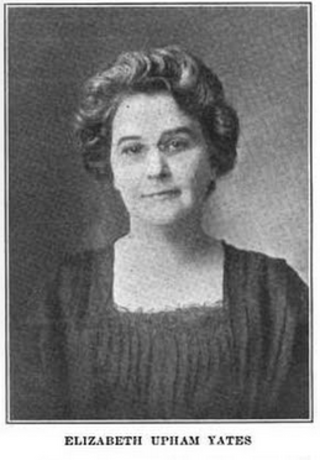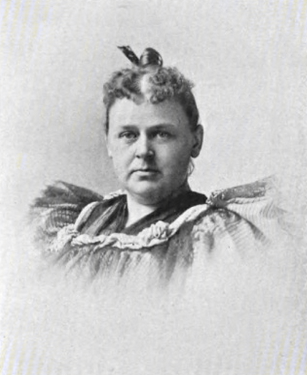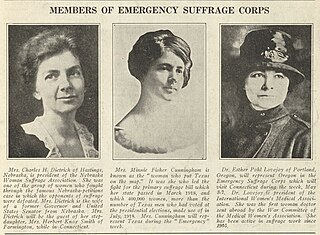
Elizabeth Daken Bacon (March 19, 1844 - December 12, 1917) was an American suffragist and educator. She served as president of the Connecticut Woman Suffrage Association (CWSA) from 1906 to 1910.

Elizabeth Daken Bacon (March 19, 1844 - December 12, 1917) was an American suffragist and educator. She served as president of the Connecticut Woman Suffrage Association (CWSA) from 1906 to 1910.
Elizabeth Daken Bacon was born on March 19, 1844, in Cranston, Rhode Island. [1] Bacon's grandfather, John Wilbur, was a Quaker minister and led a split in Quaker theology. [1] Bacon went to public school in Providence, Rhode Island, and attended Providence High School, graduating in 1864. [1] [2] She taught public school for a few years before she married James Gillispie Bacon in Providence on October 6, 1869. [3] [1] The couple had one daughter in 1873. [1]
Bacon was involved with the Woman's Christian Temperance Union (WCTU) and became interested in women's suffrage. [1] She was a member of the Hartford Equal Rights Club. [4] She testified before the United States Congress Committee on Woman Suffrage on January 28, 1896. [5] She was also involved with women voter registration and school board issues. [6] [7] [8] In 1906, she became president of the Connecticut Woman Suffrage Association (CWSA), serving in that capacity until 1910. [9] [4] [10] Bacon's daughter, Ellen M. Bolles, followed in her mother's footsteps and had served as secretary of the Rhode Island Woman Suffrage Association. [1]
Bacon died on December 12, 1917, from burn injuries sustained in her home while doing housework. [2] She was buried next to her husband in the Old North Cemetery. [1]
This timeline highlights milestones in women's suffrage in the United States, particularly the right of women to vote in elections at federal and state levels.

Women's suffrage was established in the United States on a full or partial basis by various towns, counties, states and territories during the latter decades of the 19th century and early part of the 20th century. As women received the right to vote in some places, they began running for public office and gaining positions as school board members, county clerks, state legislators, judges, and, in the case of Jeannette Rankin, as a member of Congress.

Elizabeth Upham Yates was an American suffragist and missionary in China. She was also one of the first two women to run for statewide office in Rhode Island.

The Connecticut Woman Suffrage Association (CWSA) was founded on October 28, 1869, by Isabella Beecher Hooker and Frances Ellen Burr at Connecticut's first suffrage convention. Its main goal was to persuade the Connecticut General Assembly to ratify the 19th amendment, giving women in Connecticut the right to vote. Throughout its 52 years of existence, the CWSA helped to pass local legislation and participated in the national fight for women's suffrage. It cooperated with the National Women's Suffrage Association through national protests and demonstrations. As well as advocating for women's suffrage, this association was active in promoting labor regulations, debating social issues, and fighting political corruption.

The Massachusetts Association Opposed to the Further Extension of Suffrage to Women (MAOFESW) was one of the earliest organizations formed to oppose women's suffrage in the United States. The organization was founded in May of 1895. However, MAOFESW had its roots in earlier Massachusetts anti-suffrage groups and had a publication called The Remonstrance, started in 1890.
Amelia "Mimi" Himes Walker was an American suffragist and women's rights activist. Walker was one of the Silent Sentinels who picketed outside of the White House for women's right to vote. She was arrested in 1917 and sentenced to 60 days in the workhouse. After women secured the right to vote, Walker continued to honor the efforts of the suffragists. She also promoted the Equal Rights Amendment (ERA).

Sara MacCormack Algeo, born Sara Louisa MacCormack, was an American suffragist and educator.

Katharine Ludington was an American suffragist. She was the last president of the Connecticut Woman Suffrage Association, and a founding leader of the League of Women Voters.

Even before women's suffrage efforts took off in Rhode Island, women were fighting for equal male suffrage during the Dorr Rebellion. Women raised money for the Dorrite cause, took political action and kept members of the rebellion in exile informed. An abolitionist, Paulina Wright Davis, chaired and attended women's rights conferences in New England and later, along with Elizabeth Buffum Chace, founded the Rhode Island Women's Suffrage Association (RIWSA) in 1868. This group petitioned the Rhode Island General Assembly for an amendment to the state constitution to provide women's suffrage. For many years, RIWSA was the major group providing women's suffrage action in Rhode Island. In 1887, a women's suffrage amendment to the state constitution came up for a voter referendum. The vote, on April 6, 1887, was decisively against women's suffrage.

This is a timeline of women's suffrage in Rhode Island. Women's suffrage in Rhode Island started with women's rights activities, such as convention planning and publications of women's rights journals. The first women's suffrage group in Rhode Island was founded in 1868. A women's suffrage amendment was decided by referendum on April 6, 1887, but it failed by a large amount. Finally, in 1917, Rhode Island women gained the right to vote in presidential elections. On January 6, 1920, Rhode Island became the twenty-fourth state to ratify the Nineteenth Amendment.

Annie Louise Hall was an American suffragist and saleswoman. Hall worked as a teacher for many years, but after her experiences at a settlement house in New York City, she turned to suffrage work. Hall had experience working for women's suffrage in Connecticut, Massachusetts, New Hampshire, New York, Ohio, Pennsylvania, and Rhode Island. After her women's suffrage work, she went on to work as a saleswoman and eventually retired with her life partner to Ojai, California.
Helen Rand Thayer was an American suffragist and social reformer. A pioneer in the settlement movement era, she was a co-founder and president of the College Settlements Association (CSA). She was also an alumnæ trustee of Smith College.

Catherine Mary Flanagan was an American suffragist affiliated with the Connecticut Woman Suffrage Association and later the National Woman's Party. She was among the Silent Sentinels arrested for protesting outside the White House in 1917.
Frances Ellen Burr was an American suffragist and writer from Connecticut.

Josephine Day Bennett was an American activist and suffragist from Connecticut. She was a member of the National Women's Party (NWP) and campaigned for women's suffrage outside of the White House, leading to her arrest. Bennett was also involved in other social issues and was supportive of striking workers.

Emily Pierson was an American suffragist and physician. Early in her career, Pierson worked as a teacher, and then later, as an organizer for the Connecticut Woman Suffrage Association (CWSA). After women earned the right to vote, she went back to school to become a physician in her hometown of Cromwell, Connecticut. During much of her life, she was interested in socialism, studying and observing in both Russia and China.

Caroline Ruutz-Rees was a British–American academic, educator, and suffragist. Ruutz-Rees was very involved in the women's suffrage movement in Connecticut. She served as the first head teacher of Rosemary Hall. She was also a member of the executive board of the Connecticut Woman Suffrage Association (CWSA).

Jane Elizabeth Hoyt-Stevens was an American physician and suffragist based in New Hampshire.

The Suffrage Emergency Corps was a special group of suffragists formed after nearly two-thirds of the states had ratified the Nineteenth Amendment to the United States Constitution. Only one more state was needed to ratify, and suffragists hoped they could convince Governor Marcus H. Holcomb to make his state of Connecticut the thirty-sixth. A team of women, sponsored by the National American Woman Suffrage Association (NAWSA) chose delegates from the other states to travel to Connecticut in early May 1920 to convince the governor to open a special legislative session to consider ratifying the amendment. The event garnered publicity, but it did not convince the governor to proceed with the session.
{{cite book}}: CS1 maint: numeric names: authors list (link)